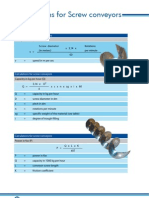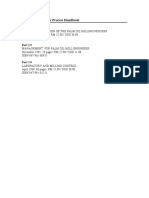0 ratings0% found this document useful (0 votes)
545 viewsPalm Oil Factory Process Handbook: Part 1 #
Palm Oil Factory Process Handbook: Part 1 #
Uploaded by
John HastingThe document discusses a monograph from 1990 on recent developments in the Malaysian palm oil industry. It describes how palm oil has become a major agricultural crop and export commodity for Malaysia, covering nearly a third of the country's cultivated land and contributing 10% to exports. The monograph examines developments in palm oil agriculture, milling, refining, quality control, new products, nutrition, and use of by-products to ensure the ongoing success of the Malaysian palm oil sector, for which Malaysia is the world's largest exporter of oils and fats.
Copyright:
© All Rights Reserved
Available Formats
Download as PDF, TXT or read online from Scribd
Palm Oil Factory Process Handbook: Part 1 #
Palm Oil Factory Process Handbook: Part 1 #
Uploaded by
John Hasting0 ratings0% found this document useful (0 votes)
545 views1 pageThe document discusses a monograph from 1990 on recent developments in the Malaysian palm oil industry. It describes how palm oil has become a major agricultural crop and export commodity for Malaysia, covering nearly a third of the country's cultivated land and contributing 10% to exports. The monograph examines developments in palm oil agriculture, milling, refining, quality control, new products, nutrition, and use of by-products to ensure the ongoing success of the Malaysian palm oil sector, for which Malaysia is the world's largest exporter of oils and fats.
Original Description:
palm oil mill
Original Title
Pub Catalog9
Copyright
© © All Rights Reserved
Available Formats
PDF, TXT or read online from Scribd
Share this document
Did you find this document useful?
Is this content inappropriate?
The document discusses a monograph from 1990 on recent developments in the Malaysian palm oil industry. It describes how palm oil has become a major agricultural crop and export commodity for Malaysia, covering nearly a third of the country's cultivated land and contributing 10% to exports. The monograph examines developments in palm oil agriculture, milling, refining, quality control, new products, nutrition, and use of by-products to ensure the ongoing success of the Malaysian palm oil sector, for which Malaysia is the world's largest exporter of oils and fats.
Copyright:
© All Rights Reserved
Available Formats
Download as PDF, TXT or read online from Scribd
Download as pdf or txt
0 ratings0% found this document useful (0 votes)
545 views1 pagePalm Oil Factory Process Handbook: Part 1 #
Palm Oil Factory Process Handbook: Part 1 #
Uploaded by
John HastingThe document discusses a monograph from 1990 on recent developments in the Malaysian palm oil industry. It describes how palm oil has become a major agricultural crop and export commodity for Malaysia, covering nearly a third of the country's cultivated land and contributing 10% to exports. The monograph examines developments in palm oil agriculture, milling, refining, quality control, new products, nutrition, and use of by-products to ensure the ongoing success of the Malaysian palm oil sector, for which Malaysia is the world's largest exporter of oils and fats.
Copyright:
© All Rights Reserved
Available Formats
Download as PDF, TXT or read online from Scribd
Download as pdf or txt
You are on page 1of 1
9.
Palm Oil Factory Process Handbook
Part 1 #
GENERAL DESCRIPTION OF THE PALM OIL MILLING PROCESS
March 1985. 109 pages. RM 32.00 / USD 30.00
ISBN 967-961-007-1
Part 2 #
MANAGEMENT FOR PALM OIL MILL ENGINEERS
November 1985. 20 pages. RM 22.00 / USD 11.00
ISBN 967-961-009-8
Part 3 #
LABORATORY AND MILLING CONTROL
April 1986. 60 pages. RM 32.00 / USD 30.00
ISBN 967-961-012-8
10. PORIM Monographs
No. 1 #
RECENT DEVELOPMENT IN THE MALAYSIAN PALM OIL INDUSTRY
Abdul Halim Hassan
November 1990. 120 pages. RM 22.00 / USD 12.00
The palm oil industry has grown to become a very important component of Malaysias
agriculture sector. Oil palm covers nearly a third of Malaysias total cultivated area and
contribute about 10% of the countrys export earnings.
Palm oil has become a major commodity in the world market for oils and fats.
Malaysia is not only the leading exporter of palm oil but also the largest single exporter
of oils and fats in the world.
The paper discusses recent developments in the Malaysian palm oil industry with
reference to agriculture, milling, refining, quality assurance, product development,
nutrition, downstream activity and by-product exploitation.
These developments are being undertaken to ensure the continued success of the
Malaysian palm oil industry.
You might also like
- SYNOPSIS by WambeckDocument671 pagesSYNOPSIS by WambeckTeong Pei LiangNo ratings yet
- Palm Oil Mill - FFB Conveyor Sizing BDocument4 pagesPalm Oil Mill - FFB Conveyor Sizing BAmin Buhari Md Zain100% (6)
- Spect Press CB15T & CB4000L For BPK & TS MillDocument3 pagesSpect Press CB15T & CB4000L For BPK & TS Millrendra100% (1)
- Palm Oil Mill Design Procedure Ch1Document2 pagesPalm Oil Mill Design Procedure Ch1Amin Buhari Md Zain100% (3)
- FFB & SFB Conveyor-SizingDocument14 pagesFFB & SFB Conveyor-SizingAzaharimahadiNo ratings yet
- Concept of Yield PotentialDocument10 pagesConcept of Yield PotentialgaganNo ratings yet
- Mass BalanceDocument4 pagesMass BalanceRabindranath Hendy Tagore100% (3)
- Oer BoosterDocument8 pagesOer Boosteredison58100% (1)
- Palm Oil Mill ProcessDocument36 pagesPalm Oil Mill ProcessKalana Jayatillake100% (3)
- Kernel Crushing Plant Process PresentationDocument18 pagesKernel Crushing Plant Process PresentationSuryadi Putra Siregar100% (1)
- Malaysian Palm Oil IndustryDocument19 pagesMalaysian Palm Oil IndustryLai Mei EeNo ratings yet
- Fact Sheet of Palm OilDocument66 pagesFact Sheet of Palm OilShriram Prasad100% (2)
- Palm Oil Mill EffluentDocument6 pagesPalm Oil Mill Effluentankitsaxena123100% (2)
- EH - Topic 1 Reception - Final Draft 300413Document5 pagesEH - Topic 1 Reception - Final Draft 300413Amin Buhari Md Zain100% (1)
- Information About Oil Palm NutritionDocument28 pagesInformation About Oil Palm Nutritionquepos09100% (7)
- 20150806-Modipalm Presentation v2 2010.3Document46 pages20150806-Modipalm Presentation v2 2010.3David CS Chiang100% (1)
- Steriliser Type 2Document17 pagesSteriliser Type 2Amin Buhari Md Zain100% (1)
- Poeb130 YosriDocument9 pagesPoeb130 YosriNa'imusyahmi Ghazali100% (1)
- Material Balance Palm Oil MillDocument9 pagesMaterial Balance Palm Oil Millmalikldu100% (3)
- Steriliser Type 1Document21 pagesSteriliser Type 1Amin Buhari Md Zain100% (2)
- Cpo MillDocument13 pagesCpo MillHendi HendriansyahNo ratings yet
- Poeb118 PDFDocument56 pagesPoeb118 PDFDeny Handoko100% (1)
- Fresh Fruit Bunch Reception & Quality Dipom 2024Document58 pagesFresh Fruit Bunch Reception & Quality Dipom 2024Muhammad Syukry100% (2)
- Chapter 3 Technical FeasibilityDocument88 pagesChapter 3 Technical FeasibilityAnissa Munira100% (3)
- Calcul Conveioare SurubDocument2 pagesCalcul Conveioare SurubgvisanNo ratings yet
- Steam Dan Power Balance in Palm Oil Mill Dengan Pengolahan TbsDocument3 pagesSteam Dan Power Balance in Palm Oil Mill Dengan Pengolahan TbsAhmad Afandi100% (1)
- Poeb94 LohDocument10 pagesPoeb94 LohTina Rin100% (2)
- Processing of Palm Oil Mill Wastes Based On Zero WDocument9 pagesProcessing of Palm Oil Mill Wastes Based On Zero WSatria MandalaNo ratings yet
- Synopsis by WambeckDocument671 pagesSynopsis by WambeckSteve Ubiam100% (3)
- Synopsis PDFDocument670 pagesSynopsis PDFZulfan Al Hajj Harahap100% (2)
- Crude Palm Oil Mill Process IntroductionDocument2 pagesCrude Palm Oil Mill Process IntroductionMarcel MrcNo ratings yet
- Novaflow POM Industry Brochure PDFDocument36 pagesNovaflow POM Industry Brochure PDFJulhamEfendi100% (1)
- Energy BalanceDocument6 pagesEnergy BalanceAnissa Munira100% (2)
- A More Efficient Palm Oil Extraction MethodDocument19 pagesA More Efficient Palm Oil Extraction Methodnfkryh100% (2)
- Module 3 3rd Edition 2016 08 Oil PlamDocument57 pagesModule 3 3rd Edition 2016 08 Oil PlamjingsiongNo ratings yet
- Processing Station - Part 1 (Mpob HQ 21711)Document56 pagesProcessing Station - Part 1 (Mpob HQ 21711)Ameen Zenn100% (2)
- Palm Oil MillDocument11 pagesPalm Oil MillEitrah Tasnim Mohamat Kasim100% (2)
- Palm Oil Mill ProcessDocument20 pagesPalm Oil Mill Processmuhdjusri67% (3)
- 4.0 Palm OilDocument87 pages4.0 Palm OillynNo ratings yet
- Monggana Volume 1 Chapter 1 PDFDocument26 pagesMonggana Volume 1 Chapter 1 PDFAzaharimahadiNo ratings yet
- Tabel Standart Losis Minyak Sawit Standart Losis Terhadap % Contoh TBSDocument5 pagesTabel Standart Losis Minyak Sawit Standart Losis Terhadap % Contoh TBSYunus RangkutiNo ratings yet
- Material Balance Pabrik Kelapa Sawit 30 Ton PDFDocument27 pagesMaterial Balance Pabrik Kelapa Sawit 30 Ton PDFRamdani Machinetwo100% (1)
- Spesification Design Loading RampDocument3 pagesSpesification Design Loading RampFickri Hafriz100% (3)
- Precourse Intro Oil Processing - 2016Document88 pagesPrecourse Intro Oil Processing - 2016JoelCariaz100% (2)
- Pks 30 Ton Horizontal Sterilizer Pt. AfrDocument6 pagesPks 30 Ton Horizontal Sterilizer Pt. AfrDominique Mendoza80% (5)
- Kernel StationDocument163 pagesKernel StationArifal100% (1)
- Challenges Facing The Palm Oil IndustryDocument5 pagesChallenges Facing The Palm Oil Industryeanguu100% (1)
- Zero Discharge Treatment of POMEDocument9 pagesZero Discharge Treatment of POMEAnonymous DJrec2No ratings yet
- FFB Decoring Technology Revolutionizes Palm Oil Milling ProcessDocument17 pagesFFB Decoring Technology Revolutionizes Palm Oil Milling ProcesseanguuNo ratings yet
- Oil Palm Mill System and ProcessDocument18 pagesOil Palm Mill System and Processsjr141071100% (5)
- 1 Q Order Digester & Press Parts CBDocument4 pages1 Q Order Digester & Press Parts CBrendraNo ratings yet
- Palm Oil Fresh Fruit Bunches To Palm Kernel ExpellerDocument4 pagesPalm Oil Fresh Fruit Bunches To Palm Kernel ExpellerSafwan Ghafar100% (1)
- Pub Catalog9 PDFDocument1 pagePub Catalog9 PDFsamuel okantahNo ratings yet
- Pub Catalog9 PDFDocument1 pagePub Catalog9 PDFPuLung SambadhaNo ratings yet
- Introduction To Palm OilDocument12 pagesIntroduction To Palm Oilshahira_zakariaNo ratings yet
- The Palm Oil Industry: Performance, Policies and Strategic DirectionsDocument42 pagesThe Palm Oil Industry: Performance, Policies and Strategic Directionsbarnabas leonNo ratings yet
- MPOC - Fact Sheet On Malaysian Palm Oil (2010 Version)Document66 pagesMPOC - Fact Sheet On Malaysian Palm Oil (2010 Version)sl1828100% (2)
- Agricultural Marketing Information For Selected Commodities in MalaysiaDocument19 pagesAgricultural Marketing Information For Selected Commodities in MalaysiaSafri AnsahNo ratings yet
- Edible Oil.Document9 pagesEdible Oil.Bilal RiazNo ratings yet
- Greasy Palms BuyersDocument70 pagesGreasy Palms BuyersEmun KirosNo ratings yet
- Course Outline Sept'14Document3 pagesCourse Outline Sept'14John HastingNo ratings yet
- 3.0 Electric Current: EPF 0024: Physics II 1Document30 pages3.0 Electric Current: EPF 0024: Physics II 1John HastingNo ratings yet
- Potential Risk of Paraffin Wax - RelatedDocument7 pagesPotential Risk of Paraffin Wax - RelatedJohn Hasting100% (1)
- SPE-124799-PA-Determining Wax Type Paraffin or NaphtheneDocument6 pagesSPE-124799-PA-Determining Wax Type Paraffin or NaphtheneJohn HastingNo ratings yet































































